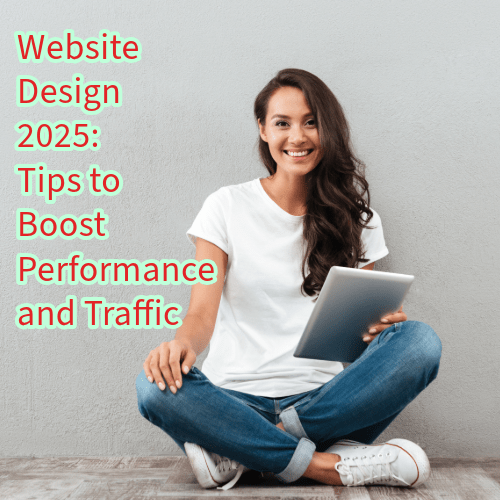
Website design is evolving, driven by technology, changing user behaviors, and new aesthetic trends. As we move into 2025, creating a high-performing, traffic-attracting website requires more than just eye-catching visuals.
It involves a harmonious blend of design, functionality, and user experience tailored to the needs of modern audiences.
Here are some tips for website design in 2025 that can help boost performance and drive more traffic.
Website Design 2025: Tips to Boost Performance and Traffic

- Prioritize Speed and Performance
In 2025, website speed will be the critical factor for user retention and SEO rankings. Users expect pages to load within two seconds or less, and slow-loading websites often result in higher bounce rates.
Tips
Use advanced caching techniques and Content Delivery Networks (CDNs) to reduce load times.
Optimize images with modern formats like WebP, which offer high quality with smaller file sizes.
Minimize JavaScript and CSS files using tools like minifies and ensure scripts are only loaded when needed.
Implement lazy loading for media and asynchronous loading for non-critical scripts.

- Embrace Minimalist and Intuitive Design
Minimalist designs are visually appealing and help improve usability. In 2025, simplicity paired with purposeful functionality will be more impactful than ever.
Tips
Use ample white space to create a clean and distraction-free layout.
Focus on a clear visual hierarchy, guiding users’ attention to the most important elements.
Ensure navigation is straightforward and intuitive, with clear labels and accessible menus.
Incorporate micro-interactions like hover effects or subtle animations to enhance user engagement.

- Optimize for Mobile-First Experiences
With over half of the global web traffic coming from mobile devices, a mobile-first approach is essential. Google’s mobile-first indexing also emphasizes the need for websites to perform well on smaller screens.
Tips
Design for mobile-first, ensuring content is readable and navigation is effortless on small screens.
Implement responsive design to provide a consistent experience across all devices.
Use touch-friendly elements with adequate spacing and size for easy interaction.
Test your website on various devices and screen sizes to ensure seamless performance.

- Incorporate AI and Personalization
Artificial Intelligence (AI) revolutionizes website design by enabling personalized user experiences. Tailoring content to individual users’ preferences can boost engagement and conversions.
Tips
Use AI-powered chatbots for real-time support and enhanced customer service.
Implement recommendation that suggest products, content, or services based on user behavior.
Leverage analytics tools to gather insights and adjust content based on user demographics and preferences.
Introduce smart search features with predictive text and voice search capabilities.

- Focus on Accessibility and Inclusivity
Creating an inclusive digital environment is a moral obligation and a practical necessity. Accessibility ensures your website can be used by everyone, including those with disabilities.
Tips
Follow Web Content Accessibility Guidelines (WCAG) to meet accessibility standards.
Provide alternative text for images, captions for videos, and clear contrast between text and background.
Ensure your website is navigable via keyboard and compatible with screen readers.
Regularly audit your site for accessibility issues and address them.

- Leverage Interactive and Immersive Elements
Interactive content and immersive design elements will be popular in 2025. They encourage users to spend more time on your site, improving engagement and reducing bounce rates.
Tips
Incorporate interactive elements like quizzes, polls, and interactive infographics.
Use 3D visuals and animations to create a dynamic experience.
Experiment with augmented reality (AR) for product visualization or virtual tours.
Avoid overloading the site with heavy animations that could impact loading speed.

- Optimize for Voice Search
With the rise of smart speakers and voice assistants, optimizing your website for voice search is becoming crucial.
Tips
Use conversational language in your content and target long-tail keywords.
Structure content with FAQ sections and headings to answer common questions.
Ensure your website’s metadata and schema markup are properly configured.
Focus on local SEO, as voice searches often have location-based intents.

- Implement Advanced SEO Strategies
Search Engine Optimization (SEO) remains critical for driving organic traffic in 2025. However, strategies are evolving with changes in search engine algorithms and user behavior.
Tips
Focus on creating high-quality, relevant, engaging content that addresses user intent.
Optimize for E-E-A-T (Experience, Expertise, Authoritativeness, Trustworthiness) factors.
Use structured data to enhance search result visibility with rich snippets.
Regularly update your content to keep it fresh and accurate.
Build high-quality backlinks to establish domain authority.

- Integrate Social Proof and User-Generated Content
Social proof can build trust and encourage new visitors to take action on your website.
Tips
Display customer reviews, testimonials, and case studies prominently.
Showcase user-generated content, such as photos or stories shared by customers.
Highlight trust badges, certifications, and awards to build credibility.
Incorporate shareable content to encourage users to engage with your brand on social media.

- Ensure Data Privacy and Security
With increasing concerns over data privacy, a secure website fosters trust among users and protects their sensitive information.
Tips
Use HTTPS and implement secure payment gateways.
Provide clear privacy policies and cookie consent banners.
Regularly update and patch your CMS, plugins, and themes to prevent vulnerabilities.
Educate users on how their data will be used and provide opt-out options.

- Harness Analytics and A/B Testing
Data-driven design is key to optimizing performance. Analytics and A/B testing can provide insights into what works and what doesn’t.
Tips
Use tools like Google Analytics and Heatmaps to monitor user behavior.
Test different versions of landing pages, CTAs, or designs to identify high-performing elements.
Continuously iterate and refine based on data-driven insights.
Track KPIs like conversion rates, session duration, and page load times.

- Adopt a Sustainable Web Design Approach
Sustainability is becoming a key consideration in website design. By reducing a website’s carbon footprint, you can benefit the environment and attract eco-conscious users.
Tips
Optimize energy efficiency by minimizing resource usage.
Choose green hosting providers that use renewable energy.
Reduce unnecessary bloat in code and media files.
Educate users about your sustainability efforts through dedicated content.

In 2025, effective website design is about creating an experience that resonates with users while meeting performance standards.
By adopting innovative technologies, businesses can craft websites that attract traffic and retain users.
Regularly reviewing trends and adapting strategies to boost your website and drive business growth.
Use these website design tips to boost performance and increase traffic in 2025.
AI Tools for You
https://www.bestprofitsonline.com/myblog/newai
Tip
How To Improve Your Social Media Marketing
